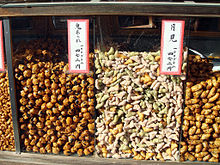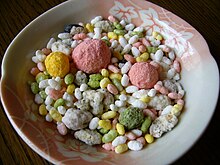Arare (food): Difference between revisions
→Culture: minor changes: changed it's to it is; italicized all uses of arare in this paragraph |
|||
| Line 12: | Line 12: | ||
Japanese typically consume ''arare'' to celebrate the [[Hinamatsuri|Doll Festival]] (''Hinamatsuri''), on March 3, Girls' Day in Japan. The ''arare'' made during the festival are very colorful - pink, yellow, white, brown, light green, and so on. Regular ''arare'' can be bought throughout the year, but the colorful ones are only available around January to March in anticipation of the Doll Festival. |
Japanese typically consume ''arare'' to celebrate the [[Hinamatsuri|Doll Festival]] (''Hinamatsuri''), on March 3, Girls' Day in Japan. The ''arare'' made during the festival are very colorful - pink, yellow, white, brown, light green, and so on. Regular ''arare'' can be bought throughout the year, but the colorful ones are only available around January to March in anticipation of the Doll Festival. |
||
''Arare'' was brought to the [[United States|U.S.]] by [[Japanese in Hawaii|Japanese immigrants]] who came as plantation workers in the early 1900s. In [[Hawaii]], the snack is often called '''''kakimochi''''' (fried rice paste) or '''mochi crunch'''. In Hawaii, it is popular to mix ''arare'' with popcorn (some people mix in [[furikake]], too). The popular [[Hurricane popcorn]] includes both arare and furikake with the popcorn. Also popular in Hawaii is [[Li hing mui|li hing]] arare. |
''Arare'' was brought to the [[United States|U.S.]] by [[Japanese in Hawaii|Japanese immigrants]] who came as plantation workers in the early 1900s. In [[Hawaii]], the snack is often called '''''kakimochi''''' (fried rice paste) or '''mochi crunch'''. In Hawaii, it is popular to mix ''arare'' with popcorn (some people mix in ''[[furikake]]'', too). The popular [[Hurricane popcorn]] includes both ''arare'' and ''furikake'' with the popcorn. Also popular in Hawaii is ''[[Li hing mui|li hing]] arare''. |
||
==See also== |
==See also== |
||
Revision as of 12:31, 23 October 2011


Arare (あられ, which is named after graupel "snow pellets") is a type of bite-sized Japanese cracker made from glutinous rice and flavored with soy sauce. The size and shapes are what distinguish arare from senbei. The name is chosen to evoke snow pellets – smaller arare are similar in size and shape to snow pellets, though others can vary significantly in size, flavour and shape.
Types
There are many different sizes, colors, and shapes of arare. Some are sweet, and others savory. One, called norimaki arare (nori meaning an edible seaweed in the form of a dried sheet; maki meaning roll shape) is wrapped with dried nori seaweed. Another, kaki no tane (柿の種), takes its name from its resemblance to a persimmon seed. (Kaki is Japanese for "persimmon".) Kaki no tane are often sold with peanuts, a combination called kakipī (かきピー). These are a popular snack to accompany Japanese beer.
Culture


Japanese typically consume arare to celebrate the Doll Festival (Hinamatsuri), on March 3, Girls' Day in Japan. The arare made during the festival are very colorful - pink, yellow, white, brown, light green, and so on. Regular arare can be bought throughout the year, but the colorful ones are only available around January to March in anticipation of the Doll Festival.
Arare was brought to the U.S. by Japanese immigrants who came as plantation workers in the early 1900s. In Hawaii, the snack is often called kakimochi (fried rice paste) or mochi crunch. In Hawaii, it is popular to mix arare with popcorn (some people mix in furikake, too). The popular Hurricane popcorn includes both arare and furikake with the popcorn. Also popular in Hawaii is li hing arare.
See also
- Agemochi
- Senbei
- Mochi
- Olive no Hana, a blend of arare.
